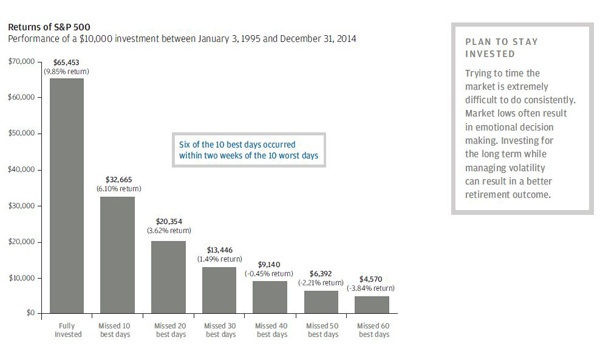Recent market volatility has likely raised fresh doubts with some investors about where the market is headed from here. The S&P 500 and the Dow Jones both fell over 10% in just a few trading days late in August,1 and concerning headlines about growth in China have persisted over the last few weeks (though the market has recovered a bit over that time).
But don’t let the volatility lure you away from your long-term investment strategy. As investors, it’s tempting to experience declines (especially when they happen quickly like in August), and to want to react—to take your portfolio more defensive or to sell out of stocks altogether. It’s human nature, but it can also hurt more than it helps.
The repercussions of ‘reacting’ can indeed have a significant impact on the investment returns you generate over time. Take a moment to study the chart below. As you can see, with $10,000 invested over 20 years, you would have over $65,000 had you stayed invested even throughout two bear markets. But if you missed just the 10 best days over that time, you would have an eyebrow-raising $30,000 less. That’s more than half of what you could have earned, in just 10 days! Miss the 40 best days, and you actually end up losing money.
Another very important insight from this chart is that downside volatility is often accompanied by upside volatility. If six of the 10 best days occurred within two weeks of the 10 worst days, that means that the stock market has demonstrated a tendency to snap back after experiencing relatively bigger declines. For investors, this means being particularly careful not to potentially overreact to the onset of downside volatility—it could mean missing some of the ‘best’ days in the markets that help produce higher long-term returns.
Address Volatility with a Portfolio Diversification Strategy
If market volatility still has you concerned, remember that you can turn to diversification as a tool to try and mitigate it. At WrapManager, we think of diversification in two layers. The first is traditional diversification, which means investing across different asset classes (stocks vs bonds), styles (value vs growth), size (small cap vs large cap) and region (foreign vs. U.S.).
The second layer is diversifying across money managers. If traditional diversification means splitting your portfolio into various ‘pie slices,’ diversifying across money managers allows you to look for specialists to manage each slice of the pie. It’s a two-tier portfolio diversification strategy that aims to help you control risk with the help of experienced money managers. In times of heightened volatility, that can mean potentially helping you avoid an emotional response that can adversely impact your long-term returns.
Diversification does not guarantee profit or protect against loss in declining markets, but to learn more about WrapManager’s unique approach to diversification, and which money managers we’re recommending now, give us a call 1-800-541-7774 or start the conversation here.
Sources:
1. CNN
2. JP Morgan






